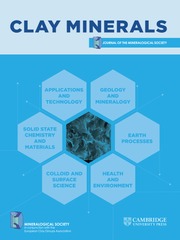No CrossRef data available.
Article contents
Elucidation of interaction mechanisms between amorphous alumina and montmorillonite in laterite
Published online by Cambridge University Press: 18 February 2025
Abstract
Laterite could play a crucial role in soil stabilization and environmental remediation, but its internal particle interaction mechanism remains unclear. This study, based on molecular dynamics simulations, used umbrella sampling methods to measure the interaction strength between amorphous alumina and montmorillonite particles in laterite. The mechanisms were explored using differential charge density analysis and bond energy analysis. The results show that the interaction process between alumina and montmorillonite exhibited initial repulsion, then attraction, followed again by repulsion. Calcium ion-induced polarization, the negative charge on the alumina surface and the bonding strength during adsorption played key roles in this interaction. Notably, the bond energy measurement results in this study are consistent with data from other related research, validating the data’s accuracy. These findings improve our understanding of the microscopic mechanisms of laterite particle interactions, providing a scientific basis for its application in soil stabilization and environmental remediation.
Information
- Type
- Article
- Information
- Copyright
- © The Author(s), 2025. Published by Cambridge University Press on behalf of The Mineralogical Society of the United Kingdom and Ireland.

